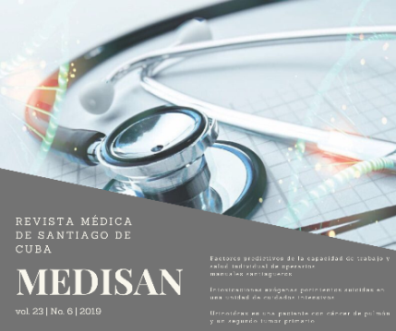Predictive factors of work capacity and individual health of hand operators from Santiago
Keywords:
work capacity rate, perceived work capacity, labor satisfaction.Abstract
Introduction: Questionnaire on Work Capacity Index rate is used in occupational health to evaluate the perceived work capacity.
Objective: To determine the perceived work capacity and its relationship with sociodemographic and labor variables.
Method: An observational, descriptive and cross-sectional investigation was carried out in workers of the Railroads Company inSantiago de Cuba, during 2016. The study population was conformed by 156 hand workers. The instrument Work Capacity rate was implemented and its confidence was evaluated with the Crombach alpha coefficient.
Results: The average age was 45 years. There was a prevalence of the male sex (87.8 %), 12 grade as school level (53.8 %), workers of mixed race (37.2 %), being married as marital status (52.6 %) and occupational category of repair operators (69.9 %). Most of them worked in turns (72.8 %), and perceived work with prevalence of physical content (54.5 %) and moderate load (62.8 %). In the instrument implemented satisfactory scores were obtained.
Conclusions: Workers perceived their work capacity as good and moderate, which was not related to age.
Downloads
References
2- Pensky A. Soluciones empresariales para los trabajadores mayores. Bremen: Instituto de Salud y Seguridad en el Trabajo. European Agency for Safety and Health at Works; 2003. (Citado 2017 marzo 30) Disponible en: http://bvs.sld.cu/revistas/rst/vol7_1-2_06/rst09106.html
3- Ilmarinen J, Tuomi K, Seitsamo J. La Nueva dimensión de habilidad de trabajo. En: Costa G, Goedhard WJA, Ilmarinen J, el ed. La valoración y Promoción de la Habilidad de Trabajo, Salud y Bienestar de Obreros Viejos. La Serie del Congreso internacional. No. 1280. Los Países Bajos: Elzeiver, 2005. (Consultado 30 marzo 2017). 3-7.Disponible en: http://bvs.sld.cu/revistas/rst/vol7_1-2_06/rst09106.html
4- Estryn-Behar M, Kreutz G, Le Nezet O, Mouchot L, Camerino D, Salles RK, Ben-Brik E, Meyer JP, Caillard JF, Hasselhorn HM. Promotion of work ability among French health care workers—value of the work ability index. International Congress Series Volume 1280, June 2005, Pages 73-78. (Consultado 30 marzo 2017) Disponible en:
http://www.sciencedirect.com/science/jornal/15315131
5- Williams SN, Criptón LL. Investigando la habilidad de trabajo de obreros más viejos. oInt J Ind. Ergon 1997; 20:241-249. (Citado 2016 nov 8) Disponible en: https://run.unl.pt/bitstream/10362/1879/1/Costa_2008.pdf
6- López GM, del Castillo NP y Oramas A. Validez de contenido y confiabilidad del cuestionario Índice de Capacidad de Trabajo en su versión cubana. Revista Cubana de Salud y Trabajo 2011;12(2) (Citado 2017 mayo 5). Disponible en: http://bvs.sld.cu/revistas/rst/vol12_2_11/rst04211.pdf
7- Albala Cecilia, Lebrão Maria Lúcia, León Díaz Esther María, Ham-Chande Roberto, Hennis Anselm J., Palloni Alberto et al. Encuesta Salud, Bienestar y Envejecimiento (SABE): metodología de la encuesta y perfil de la población estudiada. Rev. Panamericana Salud Pública [Internet]. 2005 June [Citado 2017 Apr 06]; 17(5-6): 307-322. Disponible en: http://www.scielosp.org/scielo.php?script=sci_arttext&pid=S1020-49892005000500003&lng=en http://dx.doi.org/10.1590/S1020-49892005000500003.
8-Centro de Estudios sobre Población y Desarrollo (CEPDE). El envejecimiento de la población. Cuba y sus territorios, 2003. La Habana: CEPDE; 2004. Disponible en: http://www.one.cu/publicaciones/cepde/estudiosydatos/estudios_2010.pdf
9- Bugajska J, E. Łastowiecka. Life style, work environment factors and work ability in different occupations. International Congress Series . Volume 1280, June 2005, Page 247-252. [Citado 2016 febrero 19]. Disponible en: http://www.sciencedirect.com/science/jornal/15315131
10- Arola H, Lahdenniemi M, Merisalo T, Tiitola O. el Työkykyä ylläpitävä toiminta einestehtaassa [Acciones que mantienen la habilidad de trabajo en una fábrica de comida procesada]. Työterveyslääkäri 1991; 2:27-32 [en finlandés]. (Citado 2017 febrero 24) Disponible en: https://www.ncbi.nlm.nih.gov/pubmed/11385126
11- Krause N,Lynch J,Kaplan GA,Cohen RD,Goldberg DE,Salomen JT. Predictors of disability retirement. Scand f Work Environ Health 1997, 23(Suppl.1).20-26. (Citado 2017 Febrero 9) Disponible en: https://www.ncbi.nlm.nih.gov/pubmed/9476803
12- Rodríguez Mancebo G, Maritza López Pumar G y Marrero Santos ML. Confiabilidad test-retest del cuestionario índice de capacidad de trabajo en trabajadores de la salud de servicios hospitalarios de Arroyo Naranjo, La Habana. Revista Cubana de Salud y Trabajo 2013; 14 (2): 45-54. [Citado 2017 abr 6]. Disponible en: http://bvs.sld.cu/revistas/rst/vol14_2_13/rst08213.pdf
13- Martinez Maria Carmen, Latorre Maria do Rosário Dias de Oliveira, Fischer Frida Marina. Validity and reliability of the Brazilian version of the Work Ability Index questionnaire. Rev. Saúde Pública [Internet]. 2009 June [citado 2018 Mar 23]; 43(3): 525-532. Available from: http://www.scielo.br/scielo.php?script=sci_arttext&pid=S0034-89102009000300017&lng=en. Epub Apr 03, 2009. http://dx.doi.org/10.1590/S0034-89102009005000017
14. Phongamwong C, Deema H. The impact of multi-site musculoskeletal pain on work ability among health care providers. J Occup Med Toxicol. 2015; 10: 21.
15. Emberland JS, Knardahl S. Contribution of psychological, social and mechanical work exposure to low work ability: a prospective study. J Occup Environ Med. 2015; 57 (3): 300-14.
Published
How to Cite
Issue
Section
License
All the articles can be downloaded or read for free. The journal does not charge any amount of money to the authors for the reception, edition or the publication of the articles, making the whole process completely free. Medisan has no embargo period and it is published under the license of Creative Commons, International Non Commercial Recognition 4.0, which authorizes the copy, reproduction and the total or partial distribution of the articles in any format or platform, with the conditions of citing the source of information and not to be used for profitable purposes.





